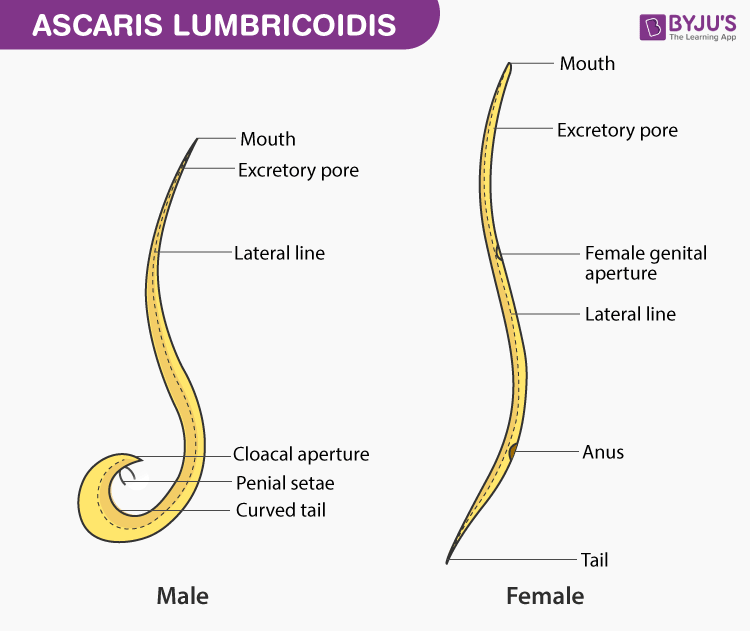Ascaris is a genus of roundworms under the phylum Nematoda. They are typically small-intestinal parasites. The most common species that affects humans is the Ascaris lumbricoides. These nematodes are unsegmented, bilaterally symmetrical, unisexual and have a pseudocoelom.
Let’s learn more about Ascaris with a description and well-labelled diagram.
Classification
|
Kingdom |
Animalia |
|
Subkingdom |
Bilateria |
|
Phylum |
Nematoda |
|
Class |
Chromadorea |
|
Order |
Ascaridida |
|
Family |
Ascarididae |
|
Genus |
Ascaris |
|
Species |
lumbricoides |
Well-labelled Diagram of Ascaris

Habitat and Distribution
The Ascaris are intestinal roundworms found in pigs and humans. These roundworms are cosmopolitan in distribution. They are mostly concentrated in China, Philippines, India, Korea and the Pacific Islands.
The A.lumbricoides species is found in man, and the A.suum is found in pigs. They have morphological similarities but are two different physiological strains. The infective egg from the pig’s Ascaris will not develop in man and vice-versa.
Ascaris – Description
- Ascaris is a yellowish-white or pinkish worm. Its epidermis is the outermost syncytial layer that covers the cuticle. The cuticle is typically a transparent, thick and non-cellular layer secreted by the epidermis.
- It has an elongated and cylindrical body that is unsegmented and bilaterally symmetrical. They show sexual dimorphism with separate female and male individuals. The females measure 20-35 cm in length, and the males measure 15-30 cm.
- The females are longer and thicker, with 4-5 mm in diameter and the males are usually 2-4 mm in diameter.
- The tail end of the male Ascaris is curved ventrally and contains a cloacal aperture. Through the cloacal aperture, two equal isospicules or penial setae project. The tail end of the female Ascaris is pointed. The anterior end of both females and males exhibits the same structures.
- The female genital aperture lies about one-third of the body from the anterior end. Asexual reproduction does not occur.
- They have no distinct head.
- Four longitudinal lines are present in both males and females – two lateral, one ventral and one dorsal line.
- The mouth is present at the anterior end and is guarded by three lips – two sub-ventral lips and one dorsal lip. Sensory papillae and amphids are present on the lips.
- They have a complete and straight digestive system with a mouth, muscular pharynx and anus.
- Circulatory and respiratory systems are absent.
- They show characteristic S-like locomotion as their muscles in the body wall work against their hydrostatic skeleton.
- The excretory pore lies at a distance of 2 mm from the anterior end, behind the mouth.
Significance
Infestation of this roundworm causes haemorrhage, insomnia, peritonitis, diarrhoea, ulcer, tumour and even death. There is no intermediate host involved in the life cycle of Ascaris. The infection is caused by the intake of contaminated water and uncooked food.
Also Check:
Keep exploring BYJU’S Biology for more such exciting topics.
Comments